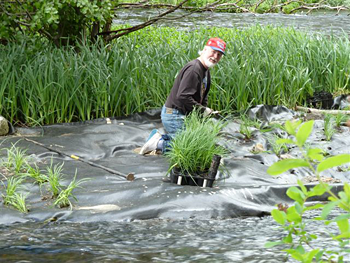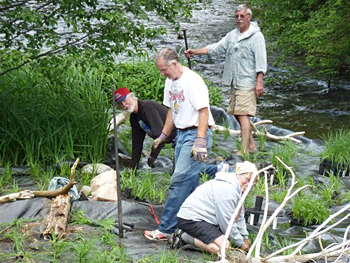Ribbon Grass Introduction A Mystery
On the island just downstream from the Camp Sherman bridge a trial method of invasive weed control is being tested. Ribbon grass, (Phalaris arundinacea picta) an ornamental variety of reed canary grass, (Phalaris arundinacea) has taken over about 70% of the island. Native plants have been displaced by the aggressive exotic on many sites along the upper Metolius River from Spring Creek down to Gorge Camp Ground and isolated spots beyond. It grows best in wet sites, but can survive in dry conditions as well. Ribbon grass can easily be identified. It is an attractive green and white striped grass, two to three feet tall. We do not know when or how it came to the Metolius, but probably many years ago some well intentioned person planted it along a waterway and it spread from there. It is sold in many commercial outlets throughout Oregon and is not on the Oregon State list of noxious weeds. It should be. The Friends of the Metolius and the US Forest Service would like to drastically reduce it’s presence along the Metolius River and restore native plants.
Solarization
The control method being tested is called solarization. A black heavy fabric was spread over the infested area in March, 2011 and will be left for two growing seasons. Without sunlight and with the high solar heat generated by the black fabric, all plants beneath the fabric die. This method has been used for decades to control unwanted plants. Here, however, we planted native sedges through the fabric in June, 2011 anticipating their survival after the fabric is removed in 2013. After that we hope the sedges will re-occupy the island. This approach has been tried successfully on other sites around Oregon.
What can go wrong? The fabric could wash off, strong winds could create openings for the ribbon grass to grow, and then there’s the element of human intervention: fishers, dogs, small boys, etc. The sedges may not flourish and maybe some ribbon grass rhizomes will survive and new shoots emerge. Never-the-less, we will learn from the effort. Hand removal and herbicide are other methods of control. We have tested these on private land and found that they too have their pros and cons. In the years to come the Forest Service will develop a control plan benefiting from what we have learned. As you watch the island in the next two years, you will have the opportunity to be part of this discussion.
Planting the sedges is labor intensive as you can see below. Approximately 300 plants were placed on the island by FOM volunteers on June 26 and 28, 2011.


Other Removal Methods
An alternative control method is chemical and we have used approved herbicides on small patches on private land in the past. Herbicides are very effective, but kill a spectrum of plants not just ribbon grass. Careful application is a must. Another alternative is hand removal. We have tried this too and found it very labor intensive and may even enhance spread by sending rhizomes downstream. Disturbance of the streambed is another problem. There is no silver bullet. Probably all three methods will have a place in a comprehensive control plan. We would like your thoughts.
In the years to come the Forest Service plans to initiate a control plan for ribbon grass, yellow iris (another noxious plant) and maybe some yet to be discovered invasive plant along the Metolius. Along with the Forest Service, Jefferson County Weed Control, Oregon Department of Agriculture and other organizations Friends is struggling to control exotic, aggressive plants that threaten our native plant communities. We want the public to be aware of the problem and to support future efforts. What do you think should be done?
In addition to ribbon grass, spotted knapweed, toadflax, and yellow iris also pose a threat to native plants along the Metolius. For additional information contact Pete Schay, Friends of the Metolius, 541-595-2118 or Maret Pajutee, US Forest Service, Sisters Ranger District.


